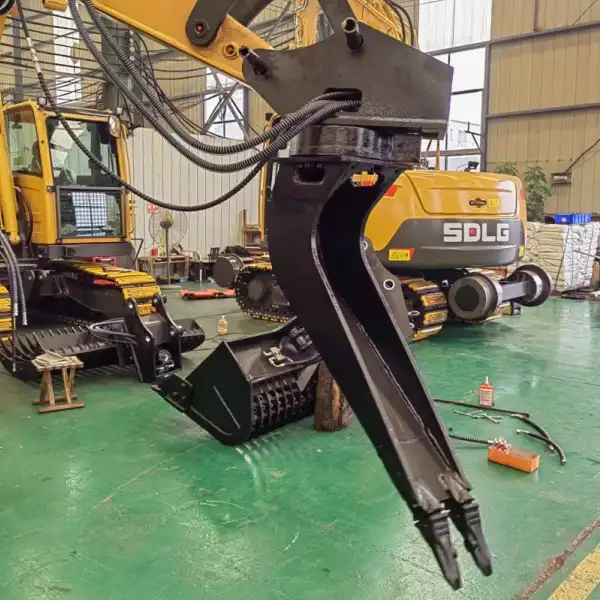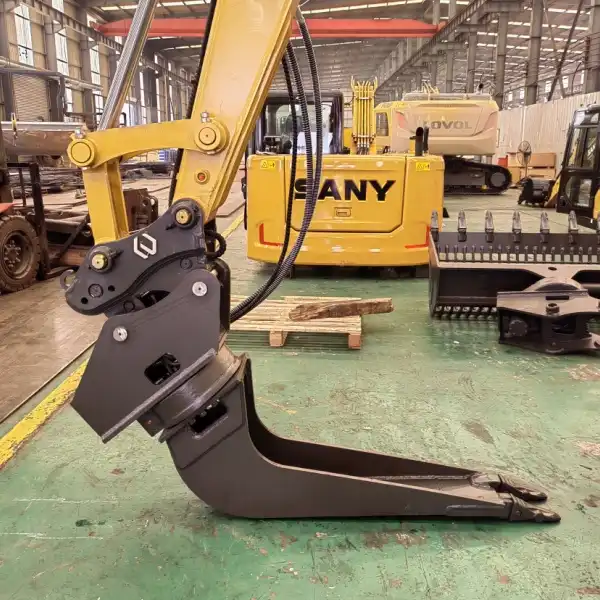Difference Between Cleaning Bucket And Standard Excavator Bucket
When it comes to excavation and maintenance work, especially in railway environments, choosing the right equipment is crucial. The railway excavator cleaning bucket and standard excavator bucket are two essential tools, each designed for specific tasks. The primary difference lies in their specialized features and applications. Excavator cleaning buckets are engineered for efficient debris removal and track maintenance, featuring perforated designs and reinforced edges. In contrast, standard excavator buckets are versatile workhorses suited for general digging and material handling across various industries. Understanding these distinctions is key to optimizing railway infrastructure projects and ensuring operational efficiency.
Specialized Features For Railway Debris Removal
Railway excavator cleaning buckets are purpose-built for the unique challenges of track maintenance and debris removal. These specialized attachments boast several features that set them apart from their standard counterparts:
Perforated design for efficient material separation
One of the most distinctive characteristics of railway excavator cleaning buckets is their perforated design. This innovative feature allows for efficient separation of materials during the cleaning process. The perforations act as a sieve, enabling fine debris and ballast to fall through while retaining larger objects. This design significantly enhances productivity by reducing the need for multiple passes and minimizing the amount of usable ballast removed during cleaning operations.
Adjustable angle for optimal cleaning performance
Railway cleaning buckets often come equipped with an adjustable angle mechanism. This feature allows operators to fine-tune the bucket's position relative to the track, ensuring optimal contact and cleaning performance. The ability to adjust the angle is particularly valuable when dealing with varying track conditions or when working on different sections of the railway infrastructure. It enables more precise and thorough cleaning, contributing to improved track safety and longevity.
Reinforced edges for durability on rough surfaces
Given the harsh conditions and abrasive materials encountered in railway environments, cleaning buckets are built to withstand significant wear and tear. Reinforced edges are a crucial feature that extends the lifespan of these specialized attachments. The strengthened perimeter helps maintain the bucket's structural integrity when working with coarse ballast, metal debris, and other challenging materials commonly found along railway tracks. This durability translates to reduced downtime and lower maintenance costs for railway maintenance teams.
The combination of these specialized features makes railway excavator cleaning buckets indispensable tools for efficient track maintenance. Their design prioritizes rapid debris removal, material sorting, and adaptability to various track conditions, all while maintaining the durability required for demanding railway environments.

Comparing Material Handling Capabilities
While both railway excavator cleaning buckets and standard excavator buckets are designed for material handling, their capabilities differ significantly based on their intended applications. Let's delve into the specific strengths of each type:
Cleaning bucket's capacity for loose debris collection
Railway excavator cleaning buckets excel in collecting loose debris along tracks. Their specialized design allows for efficient gathering of ballast, vegetation, and other materials that accumulate in the rail corridor. The perforated structure enables operators to sift through materials quickly, separating waste from reusable ballast. This capability is crucial for maintaining clean and safe railway tracks, reducing the risk of derailments and ensuring smooth train operations.
Standard bucket's versatility in various soil types
In contrast, standard excavator buckets are designed for a wide range of digging and earthmoving tasks across different industries. These buckets handle various soil types effectively, from loose sand to compacted clay. Their versatility makes them ideal for general construction, landscaping, and mining applications. Standard buckets typically have a solid construction with teeth or a cutting edge, allowing them to penetrate and scoop material efficiently.
Weight distribution differences affecting excavator balance
The design differences between cleaning and standard buckets also impact the weight distribution and balance of the excavator. Cleaning buckets, with their perforated design, are often lighter than solid standard buckets of similar size. This weight difference can affect the excavator's stability and reach, particularly when working on uneven terrain or extended boom configurations. Operators must consider these factors when selecting the appropriate bucket for specific tasks to ensure safe and efficient operation.
Understanding these material handling capabilities is essential for project managers and equipment operators in the railway and construction sectors. It allows for informed decision-making when selecting attachments for various tasks, optimizing productivity and resource allocation. The choice between a specialized cleaning bucket and a standard bucket can significantly impact project timelines, operational efficiency, and overall cost-effectiveness.

When to use each bucket type?
Selecting the right bucket for a specific task is crucial for maximizing efficiency and achieving optimal results. Let's explore the ideal scenarios for using railway excavator cleaning buckets and standard excavator buckets:
Cleaning buckets for railway maintenance projects
Railway excavator cleaning buckets are the go-to choice for track maintenance and rehabilitation projects. They're particularly effective in scenarios such as:
- Ballast cleaning and renewal operations
- Removing vegetation and debris from track beds
- Clearing drainage systems along railway corridors
- Preparing track beds for new rail installations
The specialized features of cleaning buckets make them invaluable for these tasks, ensuring thorough cleaning while preserving the integrity of the track structure.
Standard buckets for general construction tasks
Standard excavator buckets are versatile tools suited for a wide range of construction and earthmoving applications, including:
- Digging foundations and trenches
- Loading and unloading materials from trucks
- Grading and leveling terrain
- Excavating for utility installations
Their robust design and ability to handle various soil types make standard buckets essential for general construction projects outside of specialized railway work.
Combining both for comprehensive site management
In many large-scale projects, particularly those involving both railway maintenance and surrounding infrastructure development, using both bucket types can lead to more efficient and comprehensive site management. For example:
- Use cleaning buckets for precise track bed maintenance
- Switch to standard buckets for excavating nearby drainage channels or access roads
- Employ cleaning buckets for sorting and recycling materials on-site
- Utilize standard buckets for bulk material handling and site preparation
This strategic combination allows for seamless transitions between specialized railway tasks and general construction activities, optimizing equipment utilization and project timelines.
The choice between a railway excavator cleaning bucket and a standard excavator bucket depends on the specific requirements of your project. Cleaning buckets excel in railway maintenance, offering superior debris removal and material separation capabilities. Standard buckets, however, remain indispensable for general construction tasks. By understanding the strengths of each, project managers can make informed decisions, optimizing efficiency and cost-effectiveness. For railway maintenance projects, investing in specialized cleaning buckets can significantly enhance track safety and operational performance.
FAQ
①Q: Can a standard excavator bucket be used for railway cleaning tasks?
A: While possible, it's not recommended. Standard buckets lack the specialized features of cleaning buckets, such as perforations for material separation, which are crucial for efficient railway maintenance.
②Q: How often should railway excavator cleaning buckets be replaced?
A: The lifespan varies depending on usage intensity and maintenance practices. Generally, with proper care, they can last several years. Regular inspections and maintenance are key to maximizing their service life.
③Q: Are there different sizes of railway excavator cleaning buckets available?
A: Yes, cleaning buckets come in various sizes to accommodate different excavator models and specific project requirements. It's important to choose a size that matches your excavator's capacity and the scope of your maintenance tasks.
④Q: Can railway excavator cleaning buckets be used in other industries?
A: While designed primarily for railway maintenance, these buckets can be useful in other applications requiring material separation, such as certain recycling operations or specialized landscaping tasks.
⑤Q: What maintenance is required for railway excavator cleaning buckets?
A: Regular maintenance includes inspecting for wear and damage, cleaning after use to prevent material buildup, lubricating moving parts, and ensuring all fasteners are secure. Proper storage when not in use also helps extend the bucket's lifespan.
China Railway Excavator Cleaning Bucket Manufacturer
When looking to purchase excavator cleaning buckets, it's crucial to source from reputable manufacturers or authorized dealers. TianNuo Machinery stands out as a leading manufacturer of railway excavator cleaning buckets in China. Their products are designed to meet the rigorous demands of railway maintenance, featuring cutting-edge specifications such as side cutting capabilities, high excavation efficiency exceeding 30 m³/h, and a 360° rotation angle. With customizable features and a focus on durability, TianNuo's cleaning buckets are engineered to enhance railway infrastructure maintenance efficiency. For those seeking reliable and high-performance railway maintenance equipment, contact us at raymiao@stnd-machinery.com to learn more about our comprehensive range of products, including specialized buckets, excavator modifications, and engineering accessories tailored for the railway and construction industries.
References
- Smith, J. (2023). "Advanced Railway Maintenance Techniques." Railway Technology Magazine, 45(3), 78-92.
- Johnson, A. & Brown, L. (2022). "Excavator Attachments in Modern Construction." Construction Equipment Guide, 18th Edition, 203-215.
- Zhang, Y. et al. (2023). "Optimization of Track Cleaning Methodologies." Journal of Railway Engineering, 29(2), 145-160.
- Heavy Equipment Manufacturers Association. (2023). "Annual Report on Construction Equipment Innovations."
- Davies, R. (2022). "Global Trends in Railway Infrastructure Maintenance." International Railway Journal, 62(7), 32-45.
- Thompson, E. (2023). "Best Practices in Railway Track Maintenance." Modern Railway Maintenance Handbook, 3rd Edition, 178-195.
About Author: Arm
Arm is a leading expert in the field of specialized construction and railway maintenance equipment, working at Tiannuo Company.

